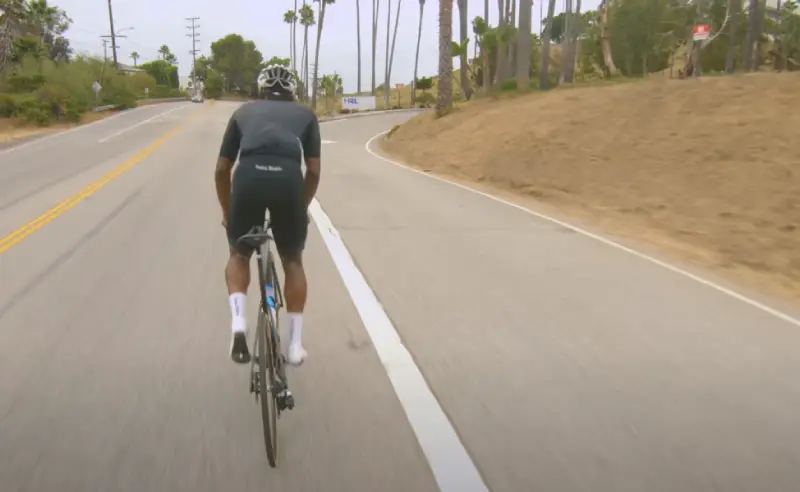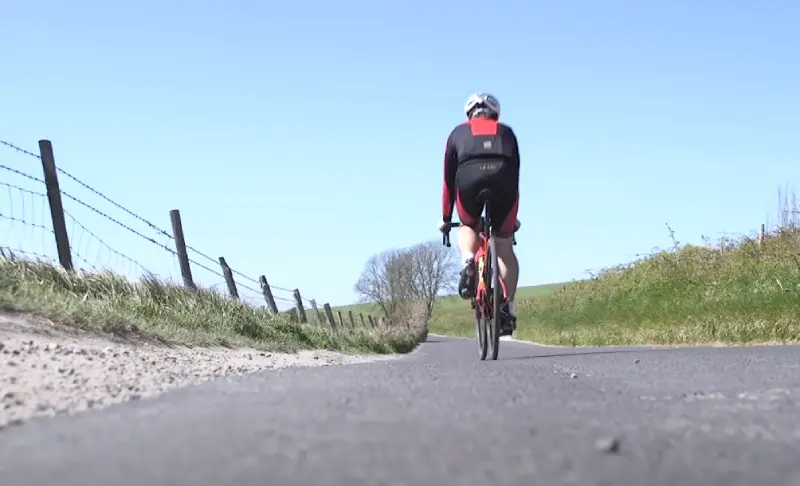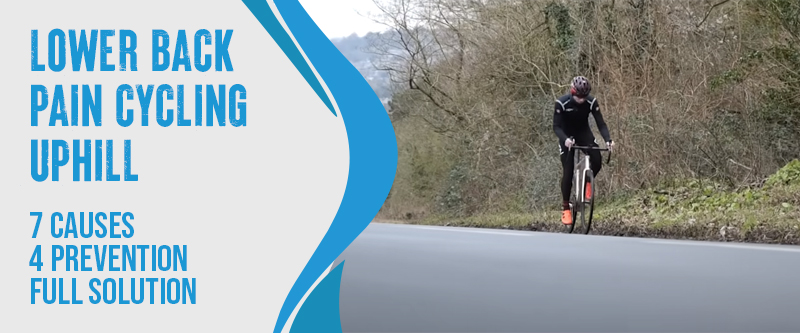Cycling uphill without proper preparation could lead to acute back pain lasting for days or weeks. Continuing with poor posture and technique may cause severe damage to muscles and joints, resulting in chronic pain. Remember your posture and technique while cycling uphill to avoid these issues.
Uphill cycling can cause lower back pain due to strain and increased load on your back, especially if you’re leaning forward or cycling too fast.
In this blog post, we will discuss Lower back pain cycling uphill, the common causes, the risks, and how to prevent and fix it.
Lower Back Pain Cycling Uphill: 4 Prevention Steps

Lower back pain is joint among cyclists, especially when cycling uphill. Not only does it affect performance and enjoyment, but it can also cause serious injuries left untreated. There are several causes:
- Improper Bike Fit: An ill-fitting bike is one of the most common causes of lower back pain. A bike that is too big or small can unnecessarily strain the lower back muscles. This can be solved by getting a professional bike fit or making necessary adjustments to the bike yourself.
- Poor Posture: Poor posture while cycling is another common cause of lower back pain. This can be due to hunching over or leaning too far forward. The solution is to maintain proper posture by holding your shoulders back and keeping your back straight.
- Cycling Technique Errors: Some cyclists may experience lower back pain because of improper cycling. This includes pedaling with too low of a cadence or standing up too often while cycling uphill. The solution is maintaining a steady beat and alternating between standing and sitting while cycling uphill.
- Overstraining and Muscle Fatigue: Excessive training and muscle fatigue can cause back pain while cycling uphill. This is often seen in experienced cyclists who push themselves too hard without proper rest and recovery. The solution is incorporating rest days into your training schedule and accumulating intensity and duration.
- Previous Back Injuries or Conditions: Cyclists with previous back injuries or conditions are more likely to experience lower back pain while cycling uphill. This can include herniated discs, spinal stenosis, and arthritis. A healthcare professional should be consulted before engaging in any strenuous physical activity.
- Weak Core and Trunk Muscles: Another cause is experiencing lower back pain while cycling uphill. The lower back muscles support and stabilize the spine while cycling. If weak, the lower back muscles can become overworked.
- Muscular Imbalances: Muscular imbalances can cause pain in the lower back when cycling uphill. When some muscles are weak and others are overworked, it can cause the lower back muscles to become strained and painful.
5 Risks of Lower Back Pain When Cycling Uphill
Cycling uphill can also damage your lower back. Research shows that cycling uphill considerably strains your lower back muscles and, if left unchecked, can lead to significant long-term issues. Here are some risks associated with cycling uphill.
Increased Risk of Chronic Pain
When cycling uphill, the strain on your lower back muscles causes everything from discomfort to excruciating pain, known as chronic pain. This pain can make it challenging to ride your bike, affecting your overall quality of life. In some severe cases, it can even limit your ability to engage in other activities outside cycling.
Decreased Cycling Performance
Lower back pain can hurt your cycling performance. You will find yourself unable to push yourself as hard as you could before and struggle to complete the same uphill routes you previously completed with ease. Lower back pain can negatively affect your entire cycling experience, which could lead you to abandon cycling altogether.
Limiting One’s Ability to Cycle
Cycling is an excellent form of exercise, but it’s challenging to carry on when you are in chronic pain. The risks of back pain on uphill rides can limit your ability to cycle altogether, a factor that could negatively affect your fitness and health.
Nerve Damage and Sciatica
Sciatica is a common condition resulting from pain in the lower back caused by cycling uphill. You have a sciatic nerve that runs through your lower back and legs and can easily compress when you cycle uphill. This compression can cause sciatica, a sharp, shooting pain down the back of your legs.
Compromised Overall Health and Wellness
The presence of lower back pain may negatively affect your overall health and wellness. It can negatively impact your posture, leading to spinal misalignment. In the long term, this can contribute to various health issues beyond cycling. Therefore, managing lower back pain proactively is essential so your health doesn’t suffer.
4 Tips for Preventing Lower Back Pain While Cycling Uphill

Cycling uphill can increase strength, endurance, and cardiovascular health. It may also cause lower back pain, particularly if proper precautions are not taken. Below are a few tips for avoiding lower back pain when cycling uphill.
Stretch and Warm Up Before Rides
Stretching and warming up before a ride can prevent lower back pain. Some effective pre-ride stretches include:
- Hip Flexor Stretch: Start with your left foot and step forward with your feet hip-width apart. Stretch out your right hip flexor by bending your left knee and bringing your right knee towards the ground. Repeat on the other side.
- Hamstring Stretch: Lie on your back with one leg straight out in front of you and the other bent. Try reaching towards your toes with the straight leg, feeling a stretch in your hamstring. Repeat on the other side.
- Lower Back Stretch: Put your feet on the ground while lying on your back. Bring both knees towards your chest, holding
onto your shins to deepen the stretch in your lower back.
Ensure Proper Bike Fit and Adjustment
Having a properly fitted and adjusted bike can make all the difference in preventing lower back pain. Here are some things to consider:
- Saddle Height: Your saddle should be adjusted to fit slightly beneath the pedal stroke. If your saddle is too low, it can cause you to round your lower back, leading to pain.
- Handlebar Height: Set your handlebar height to allow you to maintain a comfortable, upright posture while riding. If your handlebars are low, that might make you hunch over, leading to pain in your lower back.
- Cleat Position: Properly adjust your cleats if you ride with cleatless pedals. Improper cleat position can cause unnecessary strain on your lower back.
Engage in Core Strengthening Exercises
Strengthening your core will help reduce lower back pain while cycling uphill. Some exercises to try include:
- Plank: Lie face down on the ground and lift yourself on your elbows and toes, maintaining a straight line from your shoulders to your heels. Hold for 30-60 seconds.
- Bird Dog: Position yourself on your hands and knees by placing your wrists under your shoulders and your knees under your hips. Keep your left arm and right leg straight, maintaining a straight spine. Bring them back in and repeat on the other side.
- Superman: Your arms and legs should be extended while lying on your stomach. Your hands, chest, and legs should be lifted off the ground, holding them for a few seconds, then lowering them again.
Pay Attention to Posture and Form While on the Bike
Paying attention to your bike form and posture can help prevent lower back pain. Here are some tips:
- Maintain an Upright Posture: Keep your back straight and your shoulders relaxed while riding.
- Avoid Hunching Over: Keep your arms relaxed and slightly bent, and avoid leaning forward too much.
- Move Around: Shifting positions on the bike can help prevent pain by reducing pressure on any one area.
4 Ways To Fix Lower Back Pain From Cycling
As a cyclist, it’s not uncommon to experience lower back pain when riding uphill. This pain can become a real problem if not addressed properly. Here are some practical ways to ease lower back pain when cycling uphill.
Rest and Recovery
Low back pain can be easily cured by taking a break from cycling and allowing your body to recover. Resting for a few days may reduce inflammation and tension in the lower back muscles. While sleeping, you can use ice or heat therapy to ease discomfort or pain. Rest days are crucial to prevent injury and maintain your overall well-being.
Massage Therapy and Chiropractic Care
Therapy and treatment can help lower back pain caused by cycling uphill. Massage therapy can facilitate the release of tight muscles and improve blood flow, while chiropractic can reduce back pain and help realign joints. These therapies can help ease back pain symptoms and prevent future attacks.
Physical therapy Exercises and Rehabilitation
Physical therapy exercises and rehabilitation can help strengthen lower back muscles, which can prevent pain and discomfort. Strengthening exercises, such as bridges, planks, and squats, can help strengthen the muscles that support the lower back, while stretching exercises, such as the cobra pose and the cat-cow stretch, can help improve flexibility and release tension.
Adjustments to Bike Fit and Equipment

Adjustments to your bike fit and equipment can also help ease lower back pain from cycling uphill. Ensuring your bike fits will help distribute your weight more evenly and protect your lower back. A padded bike seat or padded cycling shorts can help reduce pressure on the lower back while cycling.
Conclusion
Lower back pain may be a common issue among cyclists, but it should not be taken lightly. Ensuring proper technique, equipment, and self-care is vital to enjoying a comfortable and safe cycling experience, from adjusting your bike saddle to incorporating core-strengthening exercises into your routine. There are many ways to prevent and ease the pain of cycling uphill.
If the pain persists or becomes chronic, it’s crucial to seek professional help to avoid longer-term health problems. You don’t have to be a seasoned pro or just start. Take the steps to protect your body and enjoy the ride.
FAQs
When Should I Seek Medical Help for Lower Back Pain While Cycling?
If your lower back pain persists for over a few days or you experience numbness or tingling in your legs, it’s best to seek medical help. The doctor will help you determine the underlying factors causing your symptoms and provide treatment recommendations.
How Can One Avoid Lower Back Pain While Cycling Uphill?
To prevent lower back pain when cycling uphill, it is essential to use proper form, including keeping the spine straight, engaging the core muscles, and maintaining good posture. Incorporating stretching and strengthening exercises can also help prevent this condition.


